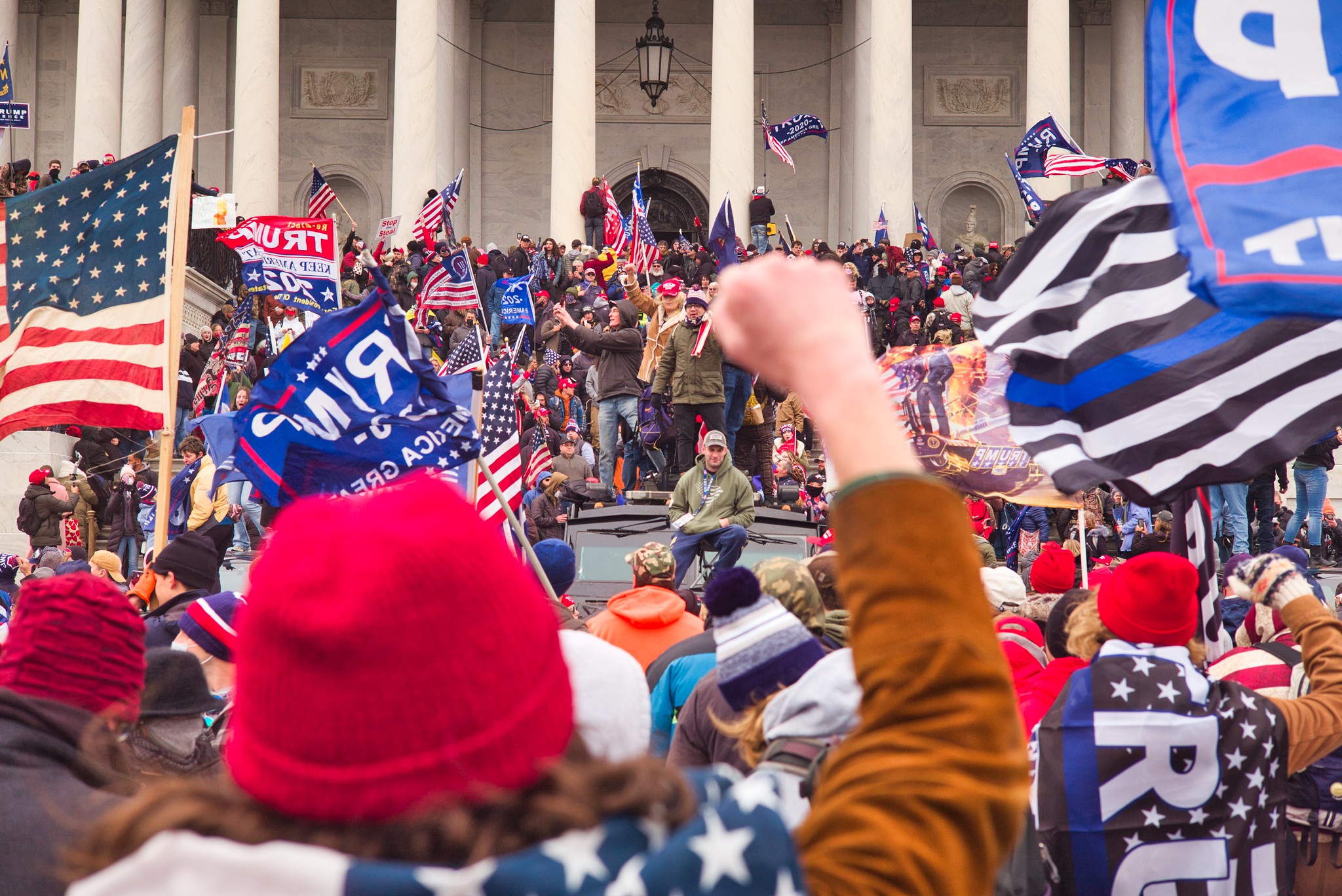The High-Water Mark of the Jan. 6 Prosecutions
On the fourth anniversary of the attack, 1,583 have been arrested and 1,270 convicted. Now how many will be pardoned?

Published by The Lawfare Institute
in Cooperation With

On the fourth anniversary of the Jan. 6 Capitol siege, the Justice Department has released what may represent the high-water-mark figures for the arrests and convictions it has amassed stemming from that event—its largest investigation in history.
At least 1,583 have been arrested and 1,270 of those individuals—80 percent—have already been convicted. Of the 1,270 convicted, 1,009 pleaded guilty—64 percent of all arrested, and 79 percent of all convictions. Another 221 were found guilty at trial by juries or judges, and the remaining 40 were convicted after a hybrid procedure known as a “stipulated trial,” at which the defendant made factual concessions without admitting to their legal significance.
Of the total 1,583 arrested, according to the department’s figures, 608—or 38 percent—were charged with either assaulting or impeding federal police officers. Of those that assaulted officers, 174 were charged with an enhanced version of the crime for using deadly or dangerous weapons or for inflicting bodily harm on the officer.
The Justice Department has been releasing statistics on the Capitol siege investigation on a monthly basis since shortly after the investigation began. Its most recent release, however, also provided some additional, forward-looking information, apparently reflecting on the turning point the United States will likely be reaching on Jan. 20. On that date, the man whose election lies led to the Capitol siege, Donald Trump, will be sworn in as the 47th president. Trump is the man who summoned all of the arrested individuals to Washington, D.C., on Jan. 6, 2021, and many defendants have said they believed they were serving Trump when they committed their crimes. Trump was himself charged with four felonies in connection with his role in the events that led to and took place on Jan. 6, but Special Counsel Jack Smith dropped those charges without prejudice after Trump’s election, in deference to longstanding policy—rooted in the executive branch’s interpretation of the Constitution—barring prosecution of sitting presidents. Trump, who denies wrongdoing, has pledged to pardon a large, unspecified number of the Jan. 6 rioters, possibly as soon as the first hour of his new term.
Despite the fateful crossroads the United States is approaching, the Justice Department’s latest updates adopt a business-as-usual posture, asserting that the investigation is ongoing. As always, in its monthly updates, the department seeks the public’s help in tracking down suspects still wanted for violent attacks on police officers on Jan. 6, as well as four charged felons who are now on the lam. The department also revealed that it is still “evaluating close to 200 cases” brought to it by the FBI, “including over 60 cases” involving assaulting or impeding federal police officers. “Keep moving, nothing to see here” is the tone the announcements seem to convey.
Because of the unusual—almost unimaginable—posture of the investigation at this juncture, I will interweave into this recap of the Justice Department’s latest figures some discussion about potential pardons.
If Trump draws lines between those who receive pardons and those who don’t, the most likely dividing line will be some attempt to distinguish between “violent” and “nonviolent” offenders. Trump has previously said—albeit in starkly different circumstances—that “there is never a justification for violence.”
It’s unclear, however, whether that declaration is still operational—assuming it ever reflected his true beliefs. He made that statement on Jan. 13, 2021, in a televised speech, one week after the attacks and the evening after the House of Representatives had impeached him for inciting insurrection. At that time, he did not yet know if the Senate would convict him of offense. As it happens, on Feb. 13, 2021, the Senate did not. But if it had, it could have also declared Trump ineligible to hold office ever again.
It was under those circumstances, in January 2021, that Trump solemnly told the nation:
Whether you are on the right, or on the left, a Democrat, or a Republican, there is never a justification for violence. No excuses. No exceptions. America is a nation of laws. Those who engaged in the attacks last week, will be brought to justice.
Assuming Trump still holds those beliefs—or ever held them— the perceived violence of each defendant’s offenses is one possible touchstone Trump might use to determine whom to pardon and whom not to. If so, it won’t be an easy line to draw. As many judges have observed, during a violent riot—at which 80 U.S. Capitol Police officers and 60 Metropolitan Police Department officers were injured, some too seriously to continue in their chosen calling—every individual unlawfully present in the Capitol building or on Capitol grounds played a role in outnumbering the police and preventing them from controlling the crowd, making arrests, and protecting lives and property. Some 180 rioters were charged with carrying weapons onto the Capitol grounds, including, according to the Justice Department, “firearms; OC [i.e., oleoresin capsicum, or “pepper”] spray; tasers; edged weapons, including a sword, axes, hatchets, and knives; and makeshift weapons, such as destroyed office furniture, fencing, bike racks, stolen riot shields, baseball bats, hockey sticks, flagpoles, PVC piping, and reinforced knuckle gloves.” Those chanting slogans—whether calling police “traitors” and “oath-breakers” or racial slurs or otherwise importuning the mob to, for instance, “Hang Mike Pence”—contributed to the circumstances that led to violence. Some rioters, though armed only with megaphones, nevertheless assumed important executive roles in the melée, advising others on where to break windows or how to circumvent or break police lines through, for instance, coordinated “heave-ho” assaults.
While the least likely to receive pardons might be those who personally assaulted police officers—especially those whose assaults were caught on videotape—not all of the 608 arrests for crimes against police officers necessarily involved “assaults.” In many contexts, the Justice Department statisticians group together two different felony charges relating to police officers. The first, known as “assaulting, resisting, or impeding” under 18 U.S.C. Section 111, typically involve unambiguous assaults or batteries on federal officers—punching them with fists, kicking them, striking them with sticks or poles; tasing them; spraying pepper or bear spray into their faces; or throwing poles, fire extinguishers, bottles, pipes, or firecrackers at them. This statute carries an eight-year maximum term which is enhanced to up to 20 years for use of a deadly or dangerous weapon or when bodily injury is caused.
Some of these 608 defendants, however, were charged with a different category of felony, which Trump might not consider “violent.” These offenders were charged with “obstruct[ing], imped[ing], or interfer[ing]” with police officers during a civil disorder, under 18 U.S.C. 231(a)(3). This is a felony punishable by up to five years imprisonment. In Capitol siege cases, the government has often used this charge when accusing the defendant of lesser bodily contact with police officers, or with threats of such contact. Defendant Thomas Robertson, for instance, an off-duty Rocky Mount, Virginia, police officer, was convicted of this offense for using a large wooden stick, held horizontally in the fashion he had been trained to use a police baton, to block the paths of Metropolitan Police Department officers who were then trying to come to the aid of the overtaxed U.S. Capitol Police officers, and making contact with two of the MPD officers. Similarly, defendant William Pope, who has not yet been tried and who denies wrongdoing, is charged with preventing officers from closing one of the Senate Carriage Doors on the east side of the building, at a time when the officers were trying evacuate rioters who were already in the building while preventing new rioters from storming in. Pope allegedly defied the officers’ orders, wedged a flagpole into a door jamb, refused to move, and resisted officers’ efforts to push him away. (Pope has told Judge Rudolph Contreras that he expects to be pardoned and he has asked permission to modify the conditions of his release to permit him to attend the inauguration, to which he says he’s been invited.)
While the Justice Department does not state precisely how many of the 608 defendants charged with crimes against officers were specifically charged with violent assaults, it appears likely that more than half of them were. The department has reported, for instance, that among the 327 defendants who have pleaded guilty to felonies, 172 pleaded guilty to assaulting police officers, while 130 admitted to the lesser offense of impeding officers. (An unspecified number pleaded to both offenses.) Of the 172 who pleaded guilty to assault, 69 defendants—about 40 percent—admitted using a deadly or dangerous weapon.
Also impossible to predict at this stage is whether Trump might categorize as “violent” or “nonviolent” those defendants who committed property crimes on Jan. 6, 2021. Some 91 rioters have been charged with destroying government property that day, while 68 were charged with stealing it. (These numbers double-count six defendants who were charged with both offenses.) The department’s statistics do not distinguish between misdemeanor and felony offenses for property crimes; the distinction hinges on the value of the property destroyed or stolen, which is typically a thorny, contested factual issue.
So far as pardons go, the potentially most controversial offenders are the conspirators. About 57 defendants were charged with conspiracy, including 18 who were charged with seditious conspiracy—a felony akin to treason that carries a maximum 20-year penalty. Ten defendants were convicted of seditious conspiracy after trial and four more pleaded guilty to the charge. All were members of either the Oath Keepers or Proud Boys, who were found to have played unique and crucial roles in facilitating and exacerbating the riot, yet very few of these individuals were charged with personally assaulting police officers. Proud Boy Enrique Tarrio, for instance—sentenced to 22 years for his leadership role in the attack—spent Jan. 6 in Baltimore, communicating with colleagues only by phone, text, or social media post.
Also, almost everyone arrested in connection with Jan. 6 was charged with federal trespass or disorderly conduct misdemeanors—either alone or along with felonies. But merely stepping into the restricted zone around the Capitol alone was almost never enough to be charged, according to the department, which says it declined prosecution of about 400 such cases. With a handful of exceptions, only those who either entered the Capitol building itself or those who engaged in other crimes outside the building—assaulting or impeding officers or destroying or stealing property, for instance—were charged with these misdemeanor offenses.
Obviously, those charged or convicted solely of misdemeanors will be the best candidates for pardons. But the Justice Department has not stated exactly how many such cases there are. We do know that among the 1,009 defendants who pleaded guilty, 327 pleaded to felony charges (32 percent) while 682 pleaded to misdemeanor offenses (68 percent). The total mix between felonies and misdemeanors is likely less lopsided than those figures suggest, however, because misdemeanor guilty pleas are much more attractive than felony guilty pleas. In a statement given on the first anniversary of the investigation, back in January 2022, U.S. Attorney General Merrick Garland suggested that about 45 percent of individuals arrested at that point had been charged with felonies while about 55 percent had been charged solely with misdemeanors.
Looking ahead—to the extent there is an ahead—where do things stand? About 1,100 of the 1,583 arrested (69 percent) have already been both convicted and sentenced. More than 700 of those people—or 44 percent of all arrested—have essentially completed their tours of the criminal justice system, having served any term of incarceration imposed, although they might still be on probation.
Another 170 individuals are now awaiting sentencing, after having been found guilty—either by plea or after trial. In addition, more than 300 have been charged, but have yet to be found guilty or not guilty. Of those last 300 individuals, about 180—or 60 percent—are charged with either assaulting or impeding police officers.
Defendant Pope, the individual who is currently scheduled for trial in June on his felony charge of impeding officers at the Senate Carriage Doors, plus six misdemeanors, is feeling quite smug about where things stand. In a jaunty, gloating pro se reply brief filed last week, asking for permission to attend the inauguration, he concluded:
As the Court knows, the American people faced a decision to either continue these prosecutions or end them, and they voted to elect the candidate who campaigned on ending them. The people’s decision is why I am being invited to the Presidential Inauguration in the first place. ...
I believe the odds are good that all my pretrial restrictions will be dropped shortly after noon on January 20, 2025, and that at that point the prosecutors assigned to this case, if they are still employed, will no longer be objecting to my presence in Washington D.C.
Respectfully submitted to the court, and Happy New Year!


-(1)-(1).png?sfvrsn=ebd4ed39_5)

